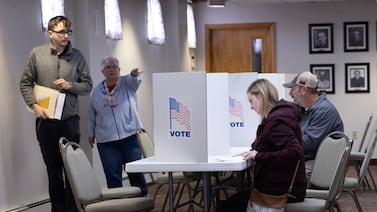Votebeat is a nonprofit news organization reporting on voting access and election administration across the U.S. Sign up for Votebeat Wisconsin’s free newsletter here.
Wisconsin has long had a photo ID requirement for voting on its books — one of the strictest in the nation. This year, voters will decide whether to make it harder to weaken that requirement.
The April 1 ballot contains a proposal that would enshrine the photo ID requirement in the state’s constitution. Republican lawmakers backed the proposed constitutional amendment in an effort to prevent the ID policy, passed in 2011, from being gutted in court.
Approval of the amendment wouldn’t affect the current ID requirement, experts say; rather, it would prevent or at least complicate future efforts to undo it.
The ballot question coming before voters on April 1 will ask whether the Wisconsin Constitution should be amended to “require that voters present valid photographic identification verifying their identity in order to vote in any election, subject to exceptions which may be established by law.”
The amendment would state, in part: “No qualified elector may cast a ballot in any election unless the elector presents valid photographic identification that verifies the elector’s identity.”
Voters can vote “yes” if they want the proposal in the constitution, and “no” if they don’t. Whichever way the amendment goes, Wisconsin would continue to have a photo ID requirement for voting, because it’s already state law.
The amendment appears likely to pass. Most constitutional amendment proposals in Wisconsin pass when they come before voters, and 74% of Wisconsinites polled in 2021 supported the photo ID requirement. The Assembly and Senate both passed the amendment proposal in January on party line votes, with Republicans in favor and Democrats against.
Making the policy a constitutional requirement, and not just a state law, makes it far less likely that a court could strike it down, said Bree Grossi Wilde, executive director of the State Democracy Research Initiative at the University of Wisconsin Law School. It also means a future Legislature can’t remove the requirement by simply repealing the statute, she said, though it would allow lawmakers to modify the requirement to some extent by creating exceptions.
It’s unclear how far those exceptions could go before they would effectively “gut the requirement” in violation of the constitution, Wilde said. Some states, for example, allow people without photo IDs to cast a ballot if they sign a legal statement affirming their identity.
“Maybe there is still wiggle room on the part of the Legislature to provide relief from the requirement in certain circumstances,” she said. “Whether you could say, ‘If you don’t have an ID, you don’t have to provide it,’ that might be too far. A court might not protect that.”
What’s the history behind photo IDs for voting?
The law that the amendment would enshrine was enacted in 2011 but faced court challenges that limited its implementation for several years. Republican proponents said it would make elections more secure by protecting against voter impersonation, something that research has shown is rare. Opponents of the law filed lawsuits alleging that the policy made it too hard to vote.
Its first use in a presidential election was in 2016, and the requirement has remained in place ever since.
The law requires voters to present their photo ID when they vote. If they can’t show ID, they can cast a provisional ballot and would have to present their photo ID afterward to have that ballot count. Acceptable photo IDs include driver’s licenses, military IDs, IDs issued by federally recognized Native American tribes, U.S. passports, some university IDs, free voting IDs issued by the Wisconsin Department of Transportation, and some other types.
Wisconsin is among nine states that have “strict photo ID” laws, according to the National Conference of State Legislatures. In these states, voters must have a photo ID when they vote, or have to vote via provisional ballot and then provide photo ID later — either to poll workers on election day or to the local election clerk within days of the election — for their ballots to count. Other states either have strict non-photo ID laws, less stringent ID requirements, or no ID requirement at all.
Researchers have found that Wisconsin’s law had a disenfranchising effect.
In the 2016 presidential election, an estimated 4,000 to 11,000 eligible people in Dane and Milwaukee counties didn’t vote mainly because they lacked an eligible photo ID, a study concluded, based on survey responses from nearly 300 registered nonvoters. The study, by then-University of Wisconsin-Madison political science professor Ken Mayer, estimated that for 8,000 to 17,000 people in those heavily Democratic counties, lack of photo ID was one of many reasons they didn’t vote.
People who were Black, who earned lower incomes, and who had less formal education were less likely to have eligible photo IDs, the study states.
Republicans widely criticized the study over its sample size and methodology. Republicans have also criticized Democrats for simultaneously arguing that photo IDs are too hard for some people to get while also saying, in their effort to encourage voting, that free voter IDs are easy to get.
The IDs are indeed free, but getting to a Division of Motor Vehicles office to obtain one isn’t, said Lauren Kunis, CEO and executive director of VoteRiders, which helps voters obtain the identification they need to vote.
“Convenience matters when we’re talking about voting,” she said. “Some of us think about voting all day, every day, and we’ll make it a priority to get your ducks in a row and get everything you need well in advance of any deadlines. But that is not the case for the average eligible voter in the United States, and we need to design policies and systems that think about that voter.”
The law’s specifications about which IDs are acceptable makes it more complicated, said Jake Spence, VoteRiders’ Wisconsin coordinator.
For example, standard IDs issued by some big state universities, including UW-Madison and UW-Milwaukee, aren’t suitable for voting. The state’s strict criteria for student ID used for voting requires them to include the date the card was issued, the student’s signature, and an expiration date no later than two years after its issuance. The standard student IDs issued at those universities don’t meet those requirements, though students can ask for compliant IDs.
Across Wisconsin, Kunis said, VoteRiders staff and volunteers have encountered not only people who couldn’t vote because they didn’t have an appropriate ID but also people who had appropriate IDs but didn’t vote because they were confused by the law, sometimes unaware that their ID met the requirements.
What should I know about the proposed amendment?
Republican proponents say they want to put the law in the constitution to keep the liberal-majority Wisconsin Supreme Court from striking down the photo ID requirement, especially if liberal candidate Susan Crawford, who argued against the ID rule in court, wins a seat on the high court in April’s election.
“I cannot say for certain how [the] Wisconsin Supreme Court would rule on voter ID laws, but I’m also not willing to risk the Wisconsin Supreme Court, unburdened by precedent and the Wisconsin Constitution, declaring voter ID laws unconstitutional,” Republican Sen. Van Wanggaard said at a hearing on the proposal.
Democratic legislators and Democratic Gov. Tony Evers ardently opposed the proposed amendment, saying it has a disenfranchising effect.
“This is about voter suppression,” said Rep. Christine Sinicki, a Milwaukee Democrat, adding that there were people in her neighborhood who can’t get a photo ID to vote.
The measure passed nonetheless in the GOP-majority Legislature. Evers doesn’t have the power to veto constitutional amendment proposals, which must pass two successive legislatures before they can appear on the ballot.
Alexander Shur is a reporter for Votebeat based in Wisconsin. Contact Alexander at ashur@votebeat.org.




